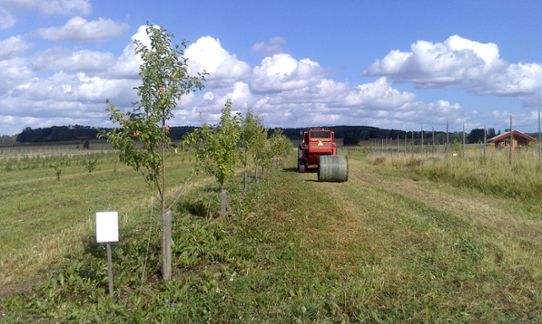Agriculture and climate change
For the agricultural sector, climate change means that natural disasters, such as flooding, storms and vegetation fires are at risk of increasing. Moreover, agriculture is at risk of becoming more vulnerable to drought as a result of longer vegetation periods and a warmer climate. It is therefore important that agriculture finds ways to adapt.
Environmental advantages and climate adaptation
Alley cropping’s rows of bushes and trees contribute to providing shade and regulating the warm temperatures at the same time that they protect crops and soil from wind erosion. The trees and bushes have root systems that are in place year-round and gather up nutrients that the crops between the rows otherwise do not have time to take up. The root systems also contribute to preventing water erosion especially if the rows are along the elevation contours. More organic materials in the soil means that water is better retained in the soil. The risks are spread over more crops as one has a varied cultivation both at ground level and at height. This makes alley cropping more robust in a changed climate. Alley cropping therefore has potential as an ecosystem-based solution for climate adaptation in agriculture.

Alley cropping at Hånsta Östgärde
At Hånsta Östgärde in Uppland, 1 hectare of alley cropping was planted with fruits, berries and nut trees in 200-metre long rows in May 2015. In the rows, apple and pear trees, as well as hazelnut and bushes of sea buckthorn and Saskatoon berry were planted. There are 12-metre spaces between the rows where the farmers continue to cultivate in organic crop rotation.

Costs
The grain area used to make space for the rows is 2 metres for each row. Since they have 1 hectare of alley cropping, this means around a 16% smaller harvest from the grain. The farmers hope that the harvest of fruits, berries and nuts in the tree and bush rows on the long term will weigh up for the reduced harvest of grain.
Altogether, the selected plants costed around SEK 50,000. A careful trimming of trees and bushes costs around SEK 2,000/40 trees. The tool used for the deep break-up for the rows costed around SEK 1,000, and SEK 1,000 for plant protection.
Financing
The project with alley cropping at Hånsta Östgärde was financed by the EU Life Plus fund, the Ekhaga Foundation and the farm itself. Ekologiska Lantbrukarna [Swedish Association of Organic Farmers] is leading the project Strategies for Organic and Low input farming to Mitigate and Adapt to Climate Change (SOLMACC).
More examples of climate adaptation
This is one of many examples of climate adaptation. There are more in the collection of ideas being built up by the Swedish National Knowledge Centre for Climate Change Adaptation at the Swedish Meteorological and Hydrological Institute (SMHI). The collection of examples has the aim of sharing experiences and providing ideas to everyone who works with climate adaptation. Examples describe concrete measures and challenges in several subject areas. They show how different actors have worked to adapt their activities to the climate changes that are already being noticed today and those that we cannot prevent in the future.